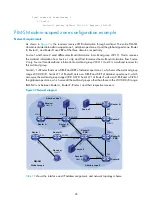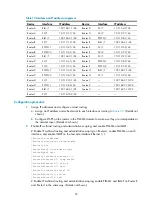
87
Step
Command
Remarks
7.
Configure the multicast source
lifetime.
source-lifetime
interval
Optional.
210 seconds by default.
Configuring common PIM timers on an interface
Step
Command
Remarks
1.
Enter system view.
system-view
N/A
2.
Enter interface view.
interface
interface-type
interface-number
N/A
3.
Configure the hello interval.
pim timer hello
interval
Optional.
30 seconds by default.
4.
Configure the maximum delay
between hello messages.
pim triggered-hello-delay
interval
Optional.
5 seconds by default.
5.
Configure the join/prune
interval.
pim timer join-prune
interval
Optional.
60 seconds by default.
6.
Configure the join/prune
timeout timer.
pim holdtime join-prune
interval
Optional.
210 seconds by default.
7.
Configure assert timeout
timer.
pim holdtime assert
interval
Optional.
180 seconds by default.
Configuring join/prune message sizes
A large join/prune message size might result in loss of a larger amount of information if a message is lost.
You can set a small value for the size of each join/prune message to reduce the impact in case of the loss
of a message.
By controlling the maximum number of (S, G) entries in each join/prune message, you can effectively
reduce the number of (S, G) entries sent per unit of time.
To configure join/prune message sizes:
Step
Command
Remarks
1.
Enter system view.
system-view
N/A
2.
Enter public network PIM view
or VPN instance PIM view.
pim
[
vpn-instance
vpn-instance-name
]
N/A
3.
Configure the maximum size
of each join/prune message.
jp-pkt-size
packet-size
Optional.
8100 bytes by default.
4.
Configure the maximum
number of (S, G) entries in
each join/prune message.
jp-queue-size
queue-size
Optional.
1020 by default.















































